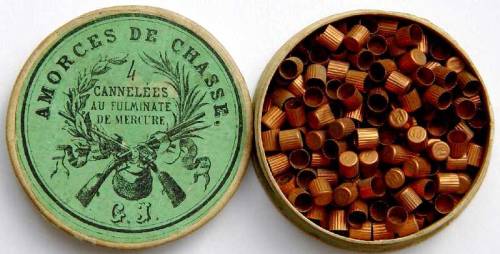Alexander Forsyth and the percussion cap,In the early 19th century Alexander John Forsyth was a Scot
Alexander Forsyth and the percussion cap,In the early 19th century Alexander John Forsyth was a Scottish Presbyterian minister and avid duck hunter. During his many duck hunting excursions, Forsyth noticed that his flintlock fowlers had a flaw which made duck hunting difficult. When the priming powder in the flash pan ignited, it would scare away the ducks before the firearm would discharge. In addition this delay in between ignition and discharge made it difficult to shoot ducks that were flying. Determined to solve this problem, Forsyth sought a new compound to replace black powder as a priming mechanism. The compound Forsyth settled on was mercury fulminate, a chemical which tended to exploded when struck with an object. Mercury fulminate provided a much faster and more efficient ignition material, and in 1807 he patented the scent bottle lock, also known as the Forsyth lock (firearm pictured above). The Forsyth lock utilized a small container filled with mercury fulminate. By taping or twisting a button, a small amount of mercury fulminate was blotted into the flashpan near the touch hole. When the hammer struck it, it would ignite the charge in the chamber.The Forsythe lock became popular with hunters in the early 19th century, especially during the Regency Period. However the military took very little notice of his invention. In fact the director of the Tower Armory would later dismiss Forsyth from his position in British Ordnance. Napoleon Bonaparte offered Forsyth £20,000 if he took his invention to France, an offer which Forsyth refused.Forsyth is often credited with the invention of the percussion cap, and although his invention served as a precursor of the percussion lock system, Forsyth didn’t invent the percussion cap himself. In fact, he actively discouraged it as he threatened gunsmiths and inventors who came up with the idea with lawsuits. Finally in 1822, an American named Joshua Shaw secured the first legal patent on the percussion cap. Much more reliable than the flintlock and Forsyth lock, the percussion cap featured a simple copper cap filled with mercury fulminate (today they use other non-mercury chemicals), which was used as the primary ignition source of firearms up to around 1870. -- source link
Tumblr Blog : peashooter85.tumblr.com
#guns#firearms#muzzleloaders#history#weapons#alexander forsyth#forsyth lock#mercury fulminate




